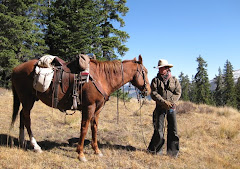 In consideration of saddling in the rain, the question was raised on how to get a horse slicker-proof.
In consideration of saddling in the rain, the question was raised on how to get a horse slicker-proof.I don’t. I hate to say that, but it’s true. You can get any horse used to it, comfortable with it, and understanding of what it is so that most of the time he or she will be just fine with it. But I’ll never underestimate the wonderful mind of horse. Being the thoughtful, thinking, yes, even sometimes moody creatures that they are, I can’t guarantee that every day they will be OK with it. Would you be if someone suddenly threw a crinkly big blanket over your back without warning?
Therefore, I never take the act of untying my slicker from the back of my saddle, shaking it open, and slipping it on for granted. Or at least, I try not to, in order to be most respectful of the horse. Instead, I take just a second to let him or her know what I’m doing. “Hey you,” I tell him or her, by sliding the rolled up slicker from behind him and allowing the horse just a second to see it, “I’m putting this on. Remember this?” If I do that, he’s fine. If I don’t have the respect for my horse, or have him so desensitized to stimulations that he’s oblivious, I don’t want to be out there with that horse.
I will “sack out” the horse to the slicker before hand, and a tarp, and a plastic bag, and many other things. This is an essential part of ground work. Approach and retreat with the scary object until the horse is comfortable with it, and has therefore decided “on his own” that he can handle it, that it’s really not so scary. With each object, we build our horses’ confidence.
I do not want to completely desensitize my horse to all objects and motions and movements and sounds. They are horses – their sensitivity is an essential part of their nature, and I don’t want to change the horses’ nature. What I can do is increase their confidence by giving him or her the opportunity to deal with and overcome many challenges; and I can give him or her the necessary tools to handle his or her sensitivity. For example, even the most bomb-proof horse, unless he or she has been so deadened by overstimulation and is in an unnatural state of mental shut down, will spook from time to time. But a spook could and should just be a quick turn towards the object to check it out further, or a quick step to the side. Who among us with a good mind does not get startled from time to time? A horse could and should learn that a scary object, or a spook, is best handled with a simple motion; not a rear, a strike, a bolt, a buck or running back to the barn.
So, I allow my horses the opportunity to become comfortable with the slicker from the ground. Very comfortable. Then I try it from the saddle at a stand still. Slowly. Give him time to get it. Then hang the slicker from a railing or tree and ride the horse over to it; have him approach it, accept it in his own terms, and slowly pull it off and allow your horse to carry it. If it’s easier to start these things from the ground with the horse in hand, take your time, and do it that way. Just give the horse time to accept it, learn it, and realize on his own terms that he’s OK with it. Allow him the time to come to his own comfort level with. Don’t rush it, push it, or force him. Encourage him. Reward him. Pat him and tell him he’s done good.
I don’t think it has ever been a problem unless I (or others) have simply not had the respect for our horse to “tell” him or her what we’re doing, and think it’s OK to just whip open the slicker and shake it all over his back all of a sudden. I don’t know about you, but if I was that horse, and someone threw a fast ball like that at me unexpectedly, I’d be a little ticked off too.





